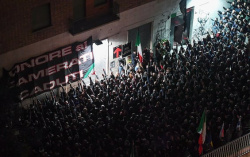Fascism
Fascism (Italian: Fascismo) in a narrow sense refers to Italian fascism, the ideology of several organizations and parties associated with Benito Mussolini, notably the National Fascist Party that ruled Italy from 1922 when it took parliamentary power in the Kingdom of Italy with the March on Rome. Claims regarding Italian fascism are controversial and vary widely, and may be problematic for reasons such as Allied psychological warfare and the associations with National Socialist Germany.
History

It was an early and influential part of the broader fascism (broad sense) movement, in Italy in particular having influences such as Italian nationalism, Ancient Rome, Futurism, and national syndicalism/corporatism.
Mussolini briefly described fascism as in a sense being totalitarianism, which is very often mentioned by critics of both Italian fascism and fascism more generally, but his meaning of the word was not the current politically correct negative meaning of the word.
Even some politically correct sources state that
- "It should be noted that there is widespread disagreement among commentators about whether Italian Fascism is properly classified as a totalitarian system. Hannah Arendt and George Kennan thought otherwise. Mussolini's regime, on such accounts, is best comprehended as an extreme form of dictatorship or, according to Juan Linz, a species of "authoritarianism." Though preeminent, it shared power with other collective actors such as the monarchy, the military, and the Catholic Church [...] Mussolini was domestically ousted in a way that indicates a far more precarious grip on power than either Hitler or Stalin evinced." and "Although the term itself was first applied by Mussolini to his fascist state, his rule of Italy—in retrospect, and in comparison with its National Socialist German and Communist Russian contemporaries—is not usually described as totalitarian. Nor does the term apply to other fascist or dictatorial regimes, such as those of Horthy in Hungary, Pilsudski in Poland, Franco in Spain, Salazar in Portugal, and Peron in Argentina."[3]
See also
- March on Rome
- Roman salute
- Fascist Manifesto
- Risiera di San Sabba - Alleged Italian Holocaust camp.
- Totalitarianism
- Voluntary Militia for National Security - The Blackshirts.
External links
Arktos Journal
Codoh
- America's Changing View of Mussolini and Italian Fascism
- Italian Fascism: An Interpretation
- The Death and Life of the Mafia in Italy, From Suppression by Mussolini to Revival by 'Liberation,' 1926-1946
- Vilfredo Pareto: Sociologist and Philosopher, Life, Work and Impact of the "Karl Marx of Fascism"
The Occidental Observer
Other
- Why do Italians still have a soft spot for Mussolini?
- Mussolini: A New Life
- The Mystery of Fascism
- Italians’ Half-Hearted Attempt at Revolution Ruined Fascism by Julius Evola
- Everybody’s a Fascist Now! by Kevin Alfred Strom
References
- ↑ One of the weapons used in the 1978 ambush by communists, a Skorpion machine gun, was later found in a Red Brigades hideout on Via Dogali in Milan in 1988. Ballistic tests revealed that the same weapon was used in three other Red Brigades murders: that of economist Ezio Tarantelli in 1985, former mayor of Florence Lando Conti in 1986, and Christian Democrat senator Roberto Ruffilli in 1988.
- ↑ Acca Larentia, centinaia di saluti romani, la Repubblica
- ↑ Totalitarianism, encyclopedia.com
da:Fascisme de:Faschismus el:Φασισμός es:Fascismo et:Fašism no:Fascisme pt:Fascismo sv:Fascism